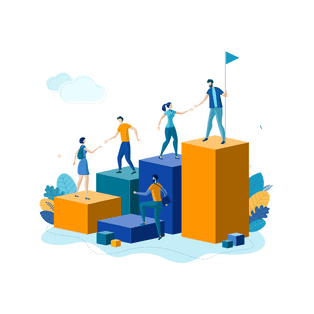Here at Celayix, we’ve spoken a lot about workforce management, and what steps you can take as a leader to get the most out of your people. Of course, workforce planning is a major part of this. The last few years have taught us how vital planning is in general, but particularly when it comes to your companies most important asset – employees.
What is Workforce Planning?

Simply put, workforce planning is a strategy. It is the strategy that businesses deploy in order to get the right people, with the right skill set, in the right place at the right time. It includes analyzing the current workforce, determining future workforce needs, and identifying the gap between the present and the future.
Strategic workforce planning also involves implementing solutions so that an organization can accomplish its mission, goals, and strategic plan through its workforce. It takes a lot of planning to ensure that the right people are on board to align with and achieve those goals!
While some businesses do not see workforce planning as an essential strategy, we can assure you that it is. Consider the effort that goes into launching a new product or service. Now, imagine putting no thought into all of the people who will be connected to that launch – R&D, logistics, supply chain, operations, sales & marketing.
Without workforce planning, that launch would not be very successful. Another reason to put time and effort into workforce management is that for most companies, people are the single largest expense. According to a study from EY, they account for 70% of operating expenses! Of course this depends on the organization and the number of employees. Can you imagine spending 70% of your budget without any planning?
What are the benefits of Workforce Planning?
As mentioned above, effective workforce planning enables organizations to achieve their goals. Aside from that, there are many other potential benefits to optimizing workforce planning which include;
- Reduce labour costs
- Identify and respond to customer needs as they change over time.
- Pinpoint inefficiencies in processes.
- Determine strategies for focused people development.
- Improve employee retention.
Let’s look at these benefits and explain how they would apply to your organization.
REDUCE LABOUR COSTS

As mentioned above, labour costs are generally the single largest expense of any company. Workforce planning allows you to identify these costs and opportunities to reduce them. Reducing labour costs doesn’t mean cutting salaries, lowballing employees, or reducing benefits.
Workforce planning focuses on getting the right people in the right places, meaning they are being more productive, engaged, and competent. In turn, you will experience lower turnover, reduced absenteeism, and in turn, reduced labor costs.
IDENTIFY AND RESPOND TO CUSTOMER NEEDS AS THEY CHANGE
As you can imagine, workforce planning involves an element of prediction. In order to achieve accurate predictions, leadership or HR (whoever is in charge of workforce planning) needs to work closely with other departments. This open communication is the key to identifying consumer trends.
Through workforce planning, organizations can spot these trends and get people in place to react to them proactively. Furthermore, in today’s dynamic work landscape, where the gig economy plays a significant role, incorporating gig workers into workforce planning strategies is essential to ensure agility and flexibility in responding to changing market demands.
PINPOINT INEFFICIENCIES IN PROCESSES
Most organizations develop business plans and processes and leave them untouched unless a problem arises. The problem with this is that companies become complacent and fail to spot inefficiencies. Workforce planning identifies these inefficiencies and aims to put the right people in place to fill gaps. It helps you manage workforce supply and demand.
It leads management to ask questions about what they should be doing or what they should stop doing. More often than not, when we review business strategies, we discover inefficiencies.
DETERMINE STRATEGIES FOR FOCUSED PEOPLE DEVELOPMENT

The basic premise of workforce planning is recognizing that businesses change, as do their long term goals. With changes in business, people also need to change and adapt their skills. Identifying talent gaps and developing plans to fill those gaps is a core premise of workforce planning.
Through this premise, you can identify opportunities to develop the skills of your people to fill talent gaps. This might involve training, education funding, or graduate programs. This prevents having to hire externally and utilizing your current workforce to its fullest potential. Planning like this enables you to develop actionable plans!
IMPROVE EMPLOYEE RETENTION
If you’ve read any of our blog posts related to employee turnover, you’ll know how costly it is. Aside from the financial impact, high turnover leads to a loss of company knowledge. Effective workforce planning prevents this from happening by creating career paths and providing opportunities for growth.
Improving retention is not just about retaining for the sake of retaining. Workforce planning identifies the employees with potential and those not serving the company’s needs.There are other benefits of efficient workforce planning. It can improve productivity levels, the quality of output, and also improve work-life balance for employees.
Workforce planning will look different for every company, depending on their industry, the size of the workforce, and the resources available to them. Now, let’s take a look at how to develop workforce planning processes and strategies.
Developing Your Strategy
According to the CIPD (Chartered Institute of Personnel & Development) – workforce planning can be broken down into two aspects:
HARD WORKFORCE PLANNING
This is all about numbers. The main goal here is to predict/identify how many people with what skill set will likely be needed to achieve an efficiently operational workforce. Using numerical and statistical data highlights the cause and effect of patterns and trends. Although it might be easy to spot these trends, understanding them in context is what will truly make the difference.

SOFT WORKFORCE PLANNING
Strategy is everything. Firstly, a framework should be developed that will help you assess the information you’ve attained from hard workforce planning. Identifying the information is one thing, but being agile and responsive to it is critical to success. Developing these frameworks and strategies will help managers make better decisions rather than being forced into action by them.
Successful Workforce Planning
With this in mind, let’s look at 4 key elements that will make your workforce planning successful.
IDENTIFY & UNDERSTAND COMPANY GOALS
The first and likely most important step to getting started is identifying and understanding the goals of the company. While these goals don’t have to be directly linked to the workforce, there will more than likely be a connection anyway. Imagine your company wants to expand into Europe, for example. A big part of that goal is having the workforce in place to research, market, and represent the company in the new market.
The key here is recognizing that your workforce directly impacts your goals and missions. Without the right people with the right skills, nothing would be achieved to the standard you are aiming for. Until leaders recognize this and invest the time and effort into workforce planning, they will struggle to meet goals.
Not only do leaders have to recognize this, but the workforce should too. Make company goals clear to your employees, and ensure they understand them. Without that understanding, it can be hard for employees to buy into the goal and dedicate themselves.
ANALYZE PRESENT GAPS IN THE ORGANIZATION

Carry out a full business analysis to help identify and understand any gaps you may have. Although workforce planning concerns your employees, you should look for gaps in all business areas. Whether it’s a process, equipment, resources, or training, your employees cannot be at their best without the tools they need to get the job done. This comes back to classic workforce management.
Getting a full picture of everything as it stands will give you a clear idea of what needs to be achieved and how to achieve it. Managers are often hesitant to do this as it identifies weaknesses they may not have previously spotted. Admitting that there are gaps and room for improvement is key to being a good leader.
PROJECT FOR THE FUTURE
As mentioned above, a big part is identifying and proactively responding to future trends. Working with company leadership, involving department heads, and conducting research is critical for workforce planning.
Managers who can spot these trends are able to identify where growth will happen or where resources need to be cut. With this insight, they will be able to adapt the workforce to meet their needs. They will also be able to determine what skills the company will need down the line, not just now. That way, they can work to train the current workforce to have those skills or take the time to find the right people and put them in the right place.
CONDUCT A FUTURE GAP ANALYSIS
Okay, so you’ve analyzed how things are now and identified what is likely to happen in the future. The final aspect of workforce planning you need to nail down is spotting where gaps might occur. Combining the 2 steps above will give you an idea of what your workforce will need down the line.

Preparing as early as possible for this will mitigate the risk of being caught off guard. This can be done by:
- Identifying existing employee skills/qualifications/short- and long-term competencies required for the planned organization.
- Identifying focused career planning and development programs
- Identifying required job knowledge and skills needed for the planned organization.
- Performing skill gap analysis of employees’ existing skills and those needed in the planned work environment.
- Performing skill gap analysis between current organizational skills and the skills required to function in the planned environment.
Although no one could have predicted a global pandemic, there were companies out there who had considered the idea that working remotely needed to be a possibility. Those are the companies that were actively investing in workforce planning. You don’t have to be a fortune teller to be adaptable, prepared, and proactive.
Flexibility is a major component of workforce planning due to the nature of how businesses change. Having a plan is great, but being able to tweak that plan to suit internal and external changes sets you apart as a leader.
Workforce planning isn’t easy, which might be why some leaders stay away from it. Shying away from the future won’t prevent it from happening. As a business owner, CEO, or manager, the best thing you can do is invest time and effort into workforce planning.





